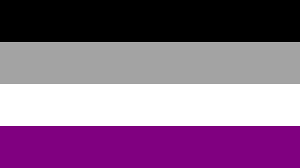#AskMeAmes: “Is there an asexual population on Campus? If so, what have their experiences been like?”

Asexual Flag
March 7, 2019
We asked you: “What do you want to know about sexuality and identity?”
In response, you asked us: “Is there an asexual population on Campus? If so, what have their experiences been like?”
“Yes, there’s definitely an asexual population on campus,” said Trinity Dearborn, vice president of Pride Alliance and Asexual Aromantic Alliance. “I see them in my daily life, they live on my floor.”
The term asexual is defined as “a person who is not sexually attracted to anyone,” according to a PDF on the Center for LGBTQIA+ Student Success website. “In its broadest sense, asexuality is the lack of sexual attraction and the lack of interest in and desire for sex. However, some asexual people might experience emotional attraction or other non-sexual attractions.”
The term aromantic, which many people may confuse with asexual, is defined “as not experiencing romantic attraction to anyone,” according to GLAAD.
A study conducted by Anthony Bogaert, a psychologist and human sexuality expert at Brock University in St. Catherines, Ontario found that 1 in every 100 adults identifies on the asexual spectrum in some way.
From sources contacted, the overall asexual aromantic experience at Iowa State is good but parts as worrisome and not as widely viewed as other LGBTQIA+ identities.
“I love the [asexual aromantic] community, we all have this bonded connection,” Dearborn said.
Kathryn Kananen, president of Asexual Aromantic Alliance, said because the asexual aromantic community is not very vocal they may be overlooked compared to identities such as gay and lesbian.
“Within the LGBTQIA+ community, there is this hierarchy ladder that happens. and in my opinion [the asexual aromantic community] tends to fall on the lower rung of that,” Kananen said.
Kananen said finding the asexual community on campus was extremely hard and took digging to even find one other asexual identifying person on campus until they created the Asexual Aromantic Alliance three years ago.
There are serious problems asexual aromantic individuals face such as corrective rape or stigmatization, and these problems could be happening at Iowa State.
“My freshman year, a friend of mine took me to a dorm room filled with guys and announced what she called “my little secret” and tried to convince them that I needed to be “fixed,” but luckily the guys weren’t bad individuals and nothing happened, it could have been much worse,” Kananen said.
Corrective or homophobic rape is when someone is raped because of their perceived sexual orientation or gender identity in an attempt to “cure” or “fix” the victim.
“People get raped for being ace [asexual] and it’s a big concern in the ace community,” Kananen said.
Dearborn said because sex is so normalized within society, the asexual aromantic community is often stigmatized as “not normal” or as outsiders, even within the LGBTQIA+ community.
“I have been called a robot, a psychopath, a flower, a bacteria,” Kananen said.
Kananen also talked about how people outside the asexual community may assume that because they don’t feel sexual attraction to someone they can’t see that someone is attractive.
“It’s like a sunset, I can see when something is beautiful but it doesn’t mean I want to have sex with it,” Kananen said.
When looking at ways to make the asexual aromantic community feel more welcome at Iowa State, Dearborn suggested normalizing the fact that there are people who identify outside the binary such as on forms that require sexual orientation by using a fill in the blank box instead of multiple choice check boxes.















